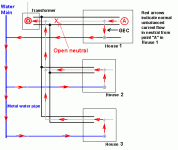Hi all, first, hello moderators. Full disclosure, I am not an electrician, but I do have an electrician working on this. He is willing to put up with my input and asking questions and picking his brain. But I would also just like to get some ideas or see if anybody has had this situation.
I live in a single-family house in a suburb with above ground powerlines and copper plumbing. I have some amps on my grounding cable (from the breaker box), which then go to my copper pipes and out of the house. And then maybe about one amp running throughout the copper pipes (mainly water, but also some gas) of the house.
When I turn off the circuit breaker in the fuse box. The main circuit breaker for the whole house, the amps on the ground wire go down to one full amp. This does fluctuate slightly throughout the day depending on what time or season. When I have a lot of appliances running, big indoor appliances, I can get maybe 7 amps or above on that cable.
The power company just replaced the service line from the pole to my house, so that obviously had a brand new neutral on it, they also tested it, so that one specific element should not be the issue.
Is there any possibility it could still be on the power company side? It just seems overwhelming on my side because no matter which appliance I use on no matter which circuit, it increases the amps on the ground cable. It’s not like it is isolated to one specific circuit. And when this does happen, it does increase the amps that run throughout the house on the various copper pipes.
Like I said, I am not an electrician, but I appreciate the heck out of any kind of person in the electrical field willing to lend some advice or thoughts.
I live in a single-family house in a suburb with above ground powerlines and copper plumbing. I have some amps on my grounding cable (from the breaker box), which then go to my copper pipes and out of the house. And then maybe about one amp running throughout the copper pipes (mainly water, but also some gas) of the house.
When I turn off the circuit breaker in the fuse box. The main circuit breaker for the whole house, the amps on the ground wire go down to one full amp. This does fluctuate slightly throughout the day depending on what time or season. When I have a lot of appliances running, big indoor appliances, I can get maybe 7 amps or above on that cable.
The power company just replaced the service line from the pole to my house, so that obviously had a brand new neutral on it, they also tested it, so that one specific element should not be the issue.
Is there any possibility it could still be on the power company side? It just seems overwhelming on my side because no matter which appliance I use on no matter which circuit, it increases the amps on the ground cable. It’s not like it is isolated to one specific circuit. And when this does happen, it does increase the amps that run throughout the house on the various copper pipes.
Like I said, I am not an electrician, but I appreciate the heck out of any kind of person in the electrical field willing to lend some advice or thoughts.

